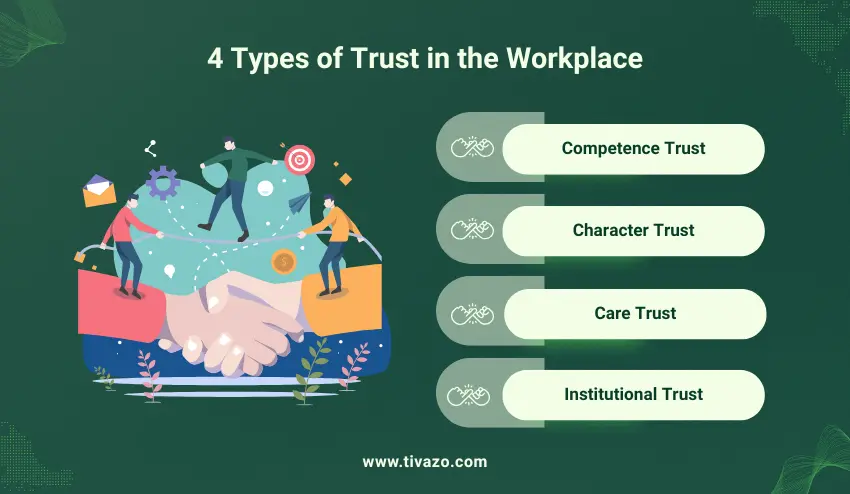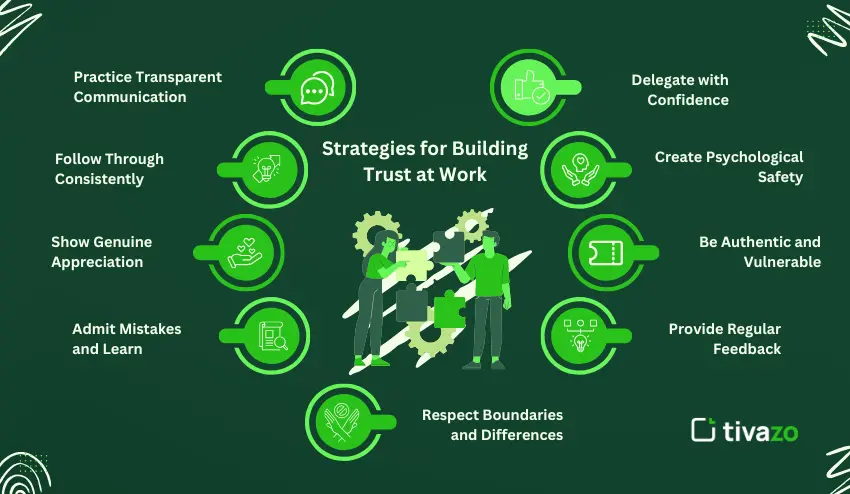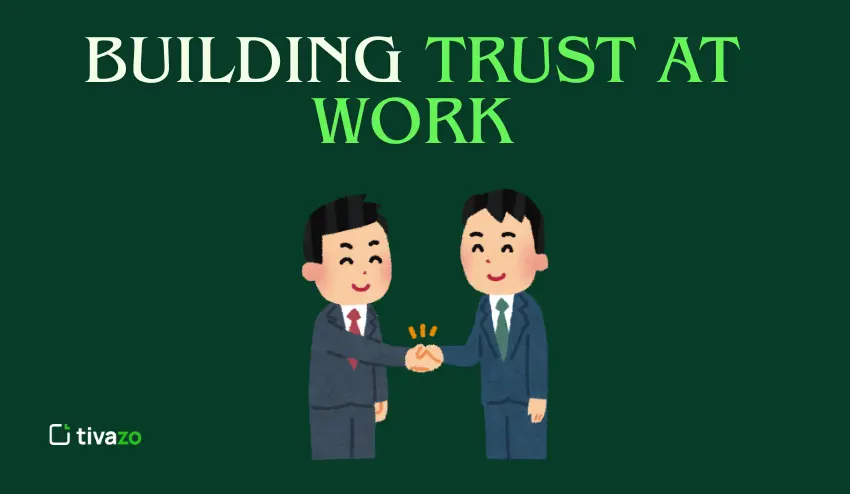Trust in the workplace is not just nice to have, it is the unseen backbone upon which all other things will occur. However, here is the ugly reality: 86% of executives indicate that they have a lot of faith in their employees, but only 60% of employees believe that they are a lot of faith. That gap? It is costing businesses billions in terms of turnover, lack of engagement and lost opportunities.
Building trust at work does not happen without purpose, whether you are a manager who wants to have a better relationship with the team you work with, an employee who wants to develop credibility with your boss, or a colleague who wants to have better work relationships. It is not so much about big gestures or company programs but rather petty, steady actions that add up.
This guide will take you through all that you need to know about developing trust at work beginning with knowing what trust is in the first place to strategies that are proven to work among managers, employees, and between peers.
What Does Building Trust at Work Really Mean?
Building trust at work is to establish trustworthy, genuine relationships in which individuals feel secure to be vulnerable, risky, and trust one another to perform their promises.

However, the trust in the workplace is not merely a single element but a combination of three main pillars, which are applicable in all situations, whether you are dealing with your boss, your subordinates, or your fellow employees in the hall.
The Three Pillars of Workplace Trust:
- Competence Trust is regarding the fact that one has the capability to perform their job effectively. When your colleague claims to take the client presentation, you believe that he or she is competent enough to do it. When your boss gives you a difficult task, he or she believes that you will know how to do it.
- Character Trust is having the confidence that a person will do the right thing even when nobody is around. It is your teammate who gives you credit on an idea in a meeting, or your boss who is lobbying your promotion behind the doors.
- Care Trust is the assumption that a person does really care about your best interests. It is when your work mate is there to save you in case of a family emergency, or when your boss protects you against unwarranted drama in the top management.
This is what makes workplace trust unlike personal relationships: you do not have to be best friends with everyone. You can believe in the competence of a coworker and not love his personality. It is possible to admire the personality of your boss and disagree with his or her decisions.
The magic is achieved when all three forms of trust are combined. It is at that time that the teams cease to play politics, begin to share actual feedback, and even enjoy going to work.
Why Building Trust at Work Matters for Employees and Managers
Trust is not a mere emotion, but it is what leads to tangible business outcomes and makes your day at work infinitely better. According to research by MIT Sloan, workers in companies with high trust levels are 260 percent more motivated, 41 percent less absentee and 40 percent burnout is less than in low-trust settings.
But here is what all those statistics really imply to your everyday life:
For Employees:
- Work is not so stressful and more rewarding when you trust your colleagues and they trust you.
- You do not spend as much time covering your back and you do meaningful work.
- You raise your voice during meetings since you are certain that your ideas will be taken into consideration.
- You accept stretch assignments since you have faith in your manager that you have your back in case things do not go smooth.
- Trust will make your career take off faster- when your boss trusts you, you will have more autonomy and interesting work.
- In cases where your peers have confidence in you, they will be willing to cooperate with you in high-profile projects.
For Managers:
- Being a leader of a high-trust team is a productivity superpower, your team solves problems on its own.
- Bad news is relayed in the team early enough so that something can be done.
- People will cooperate without you refereeing all the engagements.
- Feedback is more of a discussion rather than an argument.
- Making difficult decisions is assumed to be done with good intentions.
- Your team is, in fact, willing to see you succeed rather than merely do the motions.
For Peer Relationships:
- When all parties stick to their promises, projects are executed at a faster rate.
- This is because knowledge sharing occurs naturally rather than being forced by so-called collaboration initiatives.
- During busy times people excuse one another without score keeping.
- Good peer trusts change the dynamics in the workplace altogether.
The bottom line? The benefits of high-trust workplaces aren’t only that it is a better place to work, but it is also more successful, more innovative, and more resilient when the challenges strike. And the best part? Building trust at work begins with the simple things that we can do.
4 Types of Trust in the Workplace
Trust in the workplace does not always have a similar appearance. Knowing these four different types can assist you in realizing where you may have strong or weak trust in your relationships- and the map of building trust at work purposefully.

1. Competence Trust
This is confidence in a person to perform his or her duty. It is constructed by constant delivery, experience, and trustworthiness in accomplishing things.
What it looks like: Your colleague never misses deadlines with quality work. Your boss is very direct and makes intelligent decisions. Your project manager is aware of how to work through complicated projects without theatrics.
How to build it: Keep promises, seek clarifications when you are in doubt, generously give your knowledge and provide quality work even when doing the little things.
2. Character Trust
This is belief in the integrity and intentions of a person. It is about having faith that they will do the right thing, even when they find it challenging or when nobody is around.
What it looks like: This happens when a colleague presents your ideas to the leadership. Your supervisor is on your side when it comes to budget talks. You are informed privately by a peer about issues rather than gossiping to others.
How to build it: Confidences, be open about your mistakes, credit where credit is due and make decisions that are based on principles instead of convenience.
3. Care Trust
This is the confidence that one really cares about your wellbeing and success. It does not stop at professional courtesy but it demonstrates genuine interest in you as the individual.
What it looks like: It is when your boss visits you when you are under stress and does not want anything back. When you are handling a family emergency, a colleague takes the load of your duties. Your colleague remembers some significant things about your life and makes follow-up questions.
How to build it: Be interested in other people as individuals, be helpful even when one has not been requested to help, recall personal information that people share with him, and value relationships more than merely accomplishing tasks.
4. Institutional Trust
This is faith in systems, processes and culture of your organization. It is having faith that the company is fair and consistent in its operations to all.
What it looks like: Promotions are made on merit and not politics. HR deals with issues in a professional and confidential manner. The policies of the company are implemented in all departments and levels.
How to build it: This is a more difficult one because it is a change in the organization, yet you can play your part by adhering to the laid down procedures, treating all people equally irrespective of their status, and raising concerns in a constructive manner whenever you notice any discrepancies.
9 Proven Strategies for Building Trust at Work
Are you willing to make building trust at work a reality? These nine trust-building strategies at work are applicable regardless of whether you are building trust with your boss, with your team or with your peers. Consistency is the key to building trust at work, small actions repeated over time will result in trust.

1. Practice Transparent Communication
There should be transparency in building trust at work. It does not imply the disclosure of all the personal life and company secrets. It is being truthful with respect to what you know, what you do not know and what you are in the process of doing.
In practice: As soon as a project snarls, inform the stakeholders. Hope not to amend it in silence. When you are not sure about a decision, tell them that you have to do some research and call back. Don’t guess.
Quick tip: The no surprises rule. When there is something that impacts other people, then they must hear you out first. Not through office gossip.
2. Follow Through Consistently
Building trust at work occurs by one commitment at a time. You make a little deposit every time you do what you say you will do in the trust bank. You withdraw every time you do not.
In practice: When you say you are going to send a document on Friday, send it on Thursday. When you make a promise to a meeting, be there early and ready. When you are unable to fulfill an obligation, do so in good time. Offer solutions.
Quick tip: Promise less and deliver more. It is preferable to tell you you will be finished by Wednesday and deliver Monday. Don’t talk Monday and bring Wednesday.
3. Show Genuine Appreciation
Trust is developed by recognition since it demonstrates that you pay attention and appreciate the efforts of others. However, it must be concrete and genuine, generic great job messages are even worse than useless.
In practice: Do not say thanks for your help, but something specific. Thank you, I am glad you caught that mistake in the client proposal. To have posted that would have been a disgrace. Rather than, nice presentation, say, your data chart in slide 7 was very helpful in making me understand the customer journey.
Quick tip: Be appreciative in the open. The act of acknowledging the contribution of a person in the presence of others increases the effect of trust building.
4. Admit Mistakes and Learn
There is nothing that instills character trust more than taking the blame and not blaming others as to why one did something wrong. It demonstrates honesty and makes people feel comfortable with you as well.
In practice: Whenever you make a mistake, apply this simple formula: accept what has occurred, apologize, describe what you have learned, and tell how you will avoid it next time. You need not go into any lengthy explanations of why it was not really your fault.
Quick tip: Confess errors immediately when you know they have taken place. Waiting will give the impression that you were trying to conceal something when you were not.
5. Delegate with Confidence
Whether you are delegating to your staff as a manager or requesting a colleague to assist you, your delegation sends a strong message on trust. Micromanaging is an indication of distrust; explicit delegation is a sign of trust.
In practice: In delegating tasks, be specific on what you want but open on how to achieve it. Ask the client to have the client report containing these three sections by Thursday instead of telling the client step by step how to make it.
Quick tip: Check in, but not up. “How’s the project going? Do you need anything from me?” is quite unlike “Did you remember to call the vendor? What did they say?”
6. Create Psychological Safety
The importance of psychological safety in building trust at work is that it implies individuals are not afraid of making mistakes, posing questions, and expressing concerns without any threat of being punished or humiliated. It is the basis of all the other trust.
In practice: Each time someone presents you with a problem, thank him and then solve it. When one poses a question that appears to be obvious, respond to it without making him or her feel stupid. Whenever you find yourself in a disagreement with a person, listen with him/her, and then defend yourself.
Quick tip: Model vulnerability: You can start by sharing your own questions and uncertainties. I do not know about this either–we will work it out between ourselves makes a lot of safety as compared to acting like we know everything.
7. Be Authentic and Vulnerable
Being authentic does not imply being unprofessional, it implies being authentic within reasonable limits. People believe in people who appear authentic, rather than ideal.
In practice: Exchange desirable struggles and learning experiences. In case you are afraid of a large presentation, it is all right to speak about it. In case you are learning something new, be honest and tell yourself that you are still trying to figure out how to do it instead of trying to act like you know how.
Quick tip: Compare the degree of vulnerability that others display towards you. In case a colleague tells you of a work challenge, you can tell him/her about a work challenge. However, do not share too much about yourself that can be uncomfortable to others.
8. Provide Regular Feedback
People develop trust when they understand your position with them. Frequent, targeted feedback, both positive and constructive, does away with guesswork and demonstrates that you are interested in the development of people.
In practice: Do not wait to give feedback during formal reviews. Provide fast positive feedback on the spot: “The manner in which you addressed that challenging client call was quite impressive. To give helpful feedback, be precise and problem-oriented: “In the future, I would suggest that you send the agenda a day before so that people can have time to prepare.
Quick tip: The 5:1 ratio, five positive feedbacks to every constructive feedback. It is not about being fake, it is about paying attention and appreciating everything that people do good.
9. Respect Boundaries and Differences
Respect is needed in trust on how various individuals work, communicate, and interpret information. Your support may be overwhelming to another person.
In practice: Be sensitive to communication preferences. There are those who like in-depth emails, and those who prefer brief verbal communications. Others take time to think before they reply; others think aloud. Change your style to suit every individual.
Quick tip: When in doubt, ask. How do you think we can best provide feedback to you? or “What do you like to be told about the project? is respectful to individual differences.
7 Trust-Killing Mistakes and How to Avoid Them
Even the people with good intentions can end up hampering building trust at work. These are the most prevalent trust-killing pitfalls that hamper building trust at work and how to prevent them.
- Keeping Promises That You Cannot Keep
The fastest way to kill trust. The question before committing is: Can I do this? In case of doubt, say “Let me look into it and I will call back. Recovery: Immediately acknowledge the breaks, describe what you learned, and then act on prevention. - Gossiping behind people
Trust is killed by office gossip. Adhere to the rule of direct communication- communicate to the individual and not about him. Recovery: cease and regret directly, where necessary. - Stealing the Glory of others
Always give credit where due. Avoid saying that you invented it, say that Sarah proposed this or the team came up with this solution. Recovery: It should be corrected publicly as soon as you notice the mistake. - Being Inconsistent
Individuals must be aware of what they should anticipate of you. Form regular professional routines to ensure that your mood does not influence others. Recovery: Admit the lack of consistency and justify your improvement strategy. - Breaking Confidentiality
Do not disclose confidential information that one confided in you. In case of doubt, question “Is it confidential? Recovery: This involves being apologetic and demonstrating reliability by acting as expected in the long run. - Making Assumptions
In Building trust at work, there should be effective communication. Substitute assumptions with inquisitive questions. I saw that the report was late–all right? rather than You are not concerned with this project. Recovery: Admit that you have assumed and seek clarification. - Micromanaging
State the expectations, and take a back seat. Be result-oriented, not process-oriented. Ask “What do you need from me?” not “Did you do X?” Recovery: Accept the behavior and literally give people room to work.
The Recovery Rule: All people commit errors of trust. The difference is in the speed at which you recognize them and take action to correct them. Building trust at work is human-like, and humans do not learn without making mistakes.
Conclusion
Building trust at work is not a matter of being perfect but rather a matter of consistency. The strategies of this guide are effective, yet only when they are put in practice. Trust is built by small and repeated activities over time rather than big gestures or rapid changes. Begin with only one or two strategies which are comfortable to you. Perhaps it is keeping all your little promises. Or providing particular recognition to co-workers. Or having transparent communication in your next team meeting.
The kind of relationships you form at the workplace today will determine your future career in the years to come. Individuals deal with individuals whom they have confidence in. They advertise individuals whom they have faith in. They send opportunities to individuals whom they trust. The next thing you need to do is easy, just choose one of these trust-building actions in this guide and perform it tomorrow. Then do it again the next day. Trust is not established during meetings or training sessions, but rather during the little between meetings, following up on promises that are forgotten and being real rather than being perfect. Begin earning trust in the workplace. Your future and your career will be grateful.




